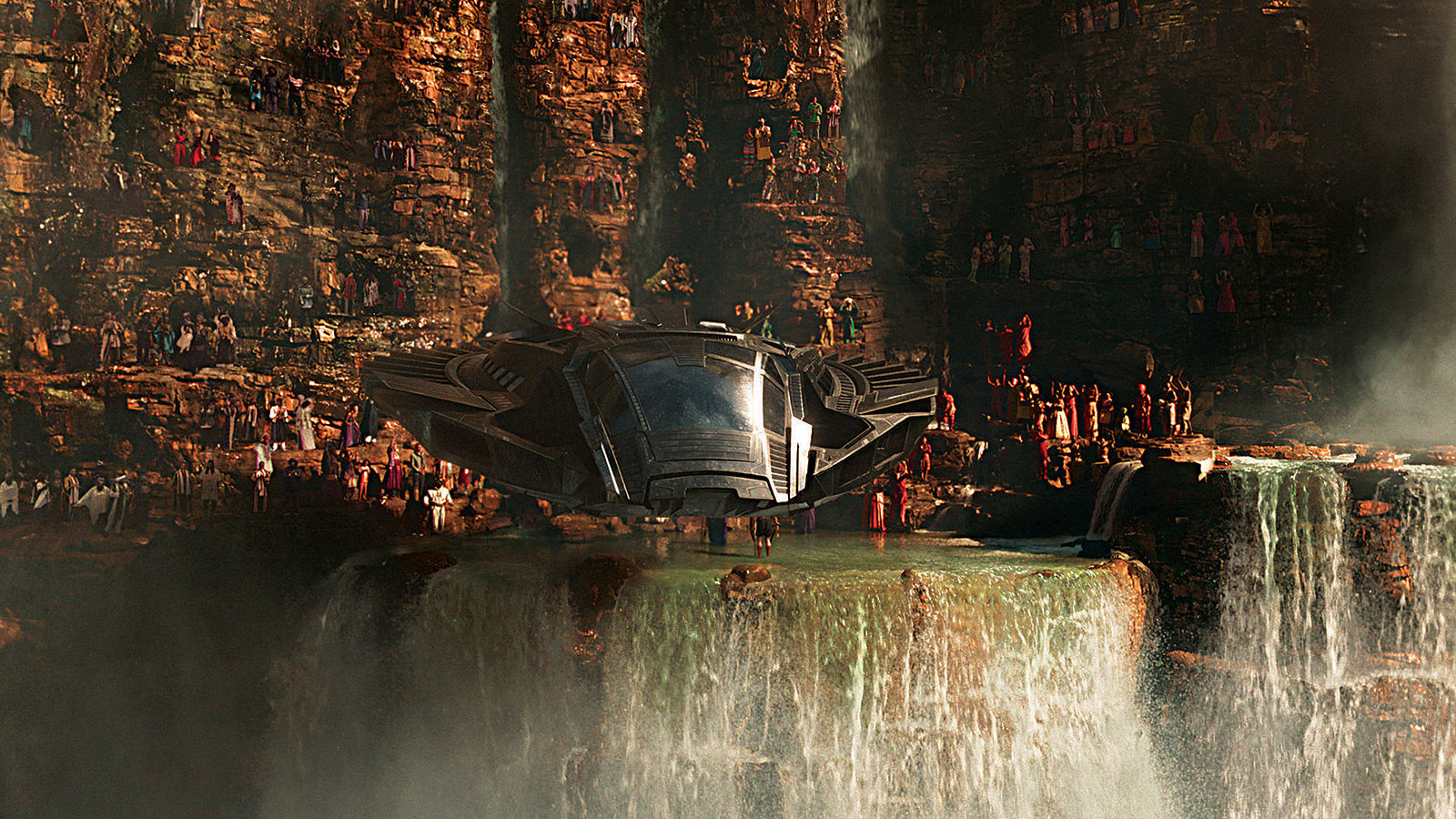
Out of This World
Science-fiction cinema has always had a paradoxical relationship with technology: while its themes usually warn us of the perils of science gone too far, its pleasures derive from the spectacular advancements of film technology. Half a century ago, special effects were the raison d’être of the American science-fiction film. A poster for 1955’s alien-invasion pic This Island Earth promised “sights of fantastic amazement never before possible on the motion picture screen!”; other classic mid-century science-fiction flicks like When Worlds Collide (1951), It Came from Outer Space (1953), and The Time Machine (1960) were marketed similarly, as Lumière-esque marvels of film technology. Their flashiness, moreover, was central to the distinctive postwar politics of these films. As Susan Sontag wrote in 1965, their “sensuous elaboration” of dystopian techno-futures allowed the viewer to “participate in the fantasy of living through one’s own death and more, the death of cities, the destruction of humanity itself.” The anxieties of an era haunted by the specter of mass destruction found an apt medium in mass spectacle.

In the last couple of decades, however, what was once the distinction of the science-fiction film is the default of Hollywood cinema; the now-hackneyed “fantasy of living through one’s own death and more” seems to signal the death of cinema itself. Due, in part, to the outsized proliferation (and templatization) of a particularly disaster-friendly subgenre of science fiction—the superhero movie—mainstream cinema is saturated with images of VFX-bloated destruction wreaked by all manner of creatures: demigods, aliens, pirates, mummies, mutants, advanced apes, sentient cars, and humans. To suggest that these movies operate within the infinitely self-contained worlds of pastiche is to state the obvious, but it is worth noting that their visual setpieces—no matter how technically polished—are increasingly abstracted from anything topical. The image of the Statue of Liberty littered across a nuclear wasteland provoked genuine and timely shock in 1968’s Planet of the Apes; the image of the titular simians of War for the Planet of the Apes prevailing over Nazi-like soldiers and escaping a snow-covered concentration camp feels, like Marvel’s endless World War II rehashings, much less relevant in 2017.
This is not to say that Cold War–era fears of fascism, dehumanization, and nuclear war are no longer socially pertinent (the opposite might be true, given the political actors currently commanding the world stage). But contemporary science-fiction and superhero blockbusters enact these scenarios without acknowledging the real ways in which they manifest in society today, or the social groups who bear their brunt. A common science-fiction trope (seen, for instance, in the X-Men series) depicts Western-style imperialism being inflicted upon white, Western peoples—i.e., a dystopian allegory of racism and colonialism with little-to-no representation of its real victims. When racial minorities do feature in such films, it’s either as token characters whose ethnicity is never meaningfully commented upon (Lando Calrissian being the classic example) or in the form of analogies that themselves reek of racism (like the insect-like, ghettoized aliens in District 9, or the orcs in Netflix’s Bright that inexplicably invoke Latinx and black stereotypes, even though those races also exist within the world of the film). Rarely does big-screen science fiction allow people of color to represent and interrogate their own lived experiences of subjugation and exploitation.
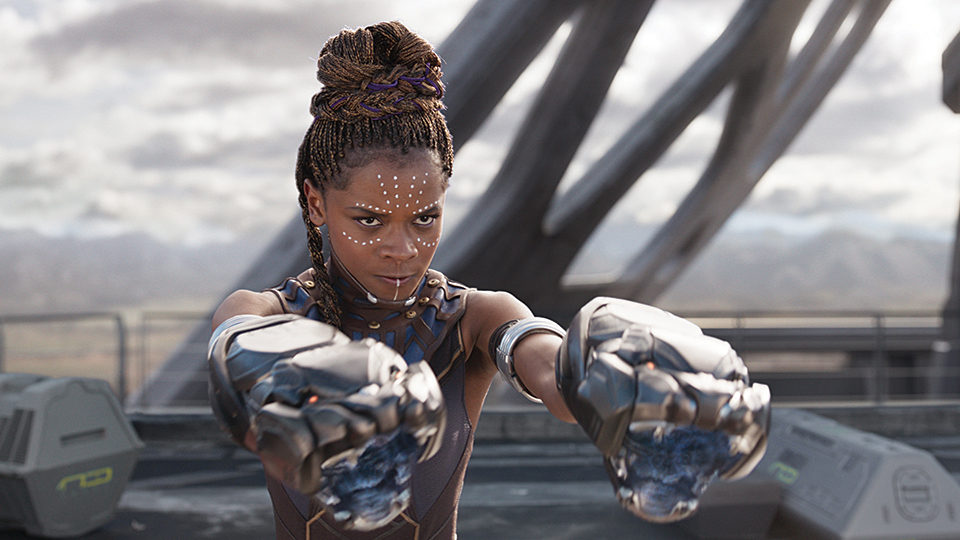
Black Panther
Ryan Coogler’s Black Panther marks a radical break in this trend. Black blockbuster superheroes are rare but not unheard of: Blade and Catwoman headlined their own movies well before T’Challa made his celluloid debut, the Falcon is a consistent (if minor) presence among the Avengers, and Luke Cage is a prominent member of the Marvel Televisual Universe. (With Storm Reid, Oprah, and Mindy Kaling in starring roles, Ava DuVernay’s forthcoming adaptation of Madeleine L’Engle’s 1962 novel A Wrinkle in Time promises to add some black and brown heroines to the science-fiction canon as well.) Black Panther, however, is closer to Afrofuturist icon Sun Ra than these costumed heroes. In his pioneering (and wonderfully bizarre) 1974 film Space Is the Place, Sun Ra envisions an Edenic black colony on a foreign planet. It would be “on the other side of time,” he says, and would rewrite African-American history. Black Panther’s T’Challa (Chadwick Boseman) reigns over an earthly, African version of such a place: Wakanda, a highly advanced techno-utopian country untouched by the ravages of colonialism. It owes its technological prowess to immense natural reserves of vibranium, and to protect these from exploitation and conflict, it hides behind Western stereotypes of Africa. “It’s a third-world country—textiles, shepherds, cool outfits,” quips Martin Freeman’s Everett Ross (one of just two white featured characters in the film) when asked what he knows about Wakanda.
Our first glimpse of Wakanda thrillingly drives home the inventiveness of this camouflage. As T’Challa and his security general Okoye (Danai Gurira) fly into Wakanda in their spaceship-like Royal Talon Fighter, they pierce through an invisible holographic barrier—Western ignorance, reified—and the mirage of rolling plains below them dissolves to reveal a gleaming metropolis set against verdant hills. It’s one of the many necessarily on-the-nose visual moments in the film that actively redefine what Africa looks like in the global imagination. Wakanda’s decision to stay isolated and hidden is also a great example of how the mythology of Black Panther is keenly attuned to the present even as it undoes the past: it is a pre-colonial fantasy all too aware of neocolonial geopolitics. When antagonist Erik Killmonger (Michael B. Jordan), a Wakandan exile raised in America, enters the film with righteous rage about the plight of the African diaspora, Wakanda has to decide whether to continue to live “on the other side of time” or reenter and intervene in the colonial history it escaped.
Although Black Panther has its share of clunky CGI setpieces (including one choppily edited chase sequence that has cars and characters whizzing around weightlessly like in a video game), it approaches technology with reverence, rather than phobia or fetishism. Wakandan tech seamlessly combines spirituality and science: traditional African beads act as all-powerful communication devices; shepherds’ capes emit electric force fields; and the high-end, neon-white lab of T’Challa’s genius sister Shuri (Letitia Wright) exists in the same universe as a mystical, purple-lit underground cave where Wakandan women tend to irradiated plants that transport Black Panther to the ancestral plane.
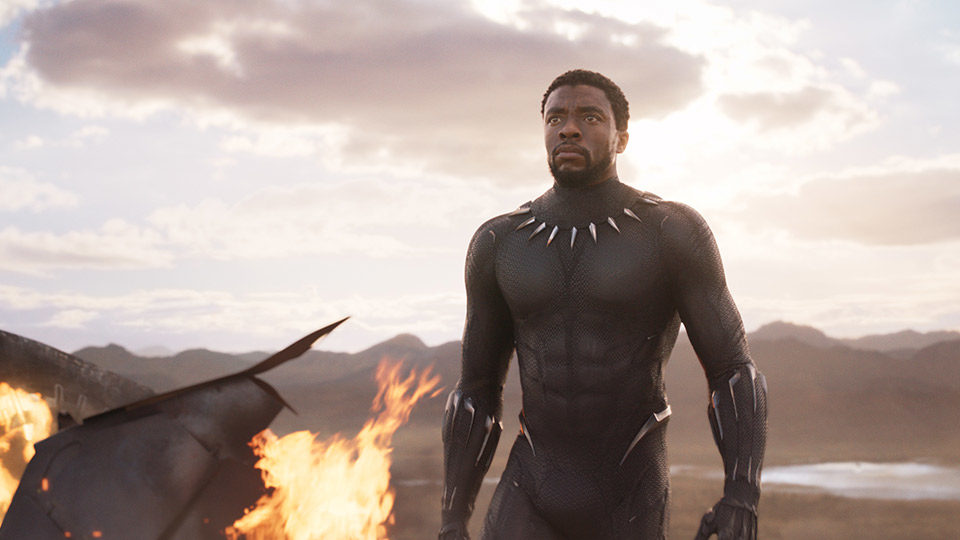
Black Panther
This is not the kooky exoticism of Dr. Strange, but a genuinely Afrofuturistic science fiction that unsettles Western conceptions of technological progressivism. Much of this aesthetic is inspired by artist Brian Stelfreeze’s vision of Wakanda in the 2016 reboot of the Black Panther comics penned by Ta-Nehisi Coates. Although Wakanda has been shaped by a number of artists and writers since Stan Lee and Jack Kirby introduced Black Panther in a 1966 Fantastic Four comic, Stelfreeze is credited with updating the country’s technology to a truly contemporary Afrofuturistic design, conceptualized as arising organically from “agricultural needs” rather than industry. With its thatch-roofed skyscrapers and bird-shaped hovercrafts, its pastel-hued, Zulu-inspired costumes and bulletproof, energy-absorbent suits, the Wakanda of the film exemplifies this vision: it looks and feels like a society where scientific advancement occurs not at the cost of, but in harmony with tradition and culture.
This imbues even the biggest action sequences in Black Panther with a sense of ritual and ceremony (or, depending on the situation, with swagger). There are martial-arts combat scenes set at the lip of a waterfall that have Coogler and Jordan re-creating kinetic Creed magic, while a sinuous long take in a casino follows Okoye, dressed in a flowing red gown, as she pulls off a series of acrobatic stunts with impeccable grace. Another of the film’s many novelties is its foregrounding of female characters: from tech-whiz Shuri to the Okoye-led all-female royal bodyguards, the Dora Milaje, to Lupita Nyong’o’s warrior-superspy Nakia, the women of Wakanda drive the narrative from the get-go. The concluding setpiece of the film, although much too long and much too CGI-laden, has moments of genuine beauty as the various tribes move as in a dance, advancing and receding according to the commands of their leader. These scenes are made all the more striking by the film’s frenetic sound, a mix of Ludwig Göransson’s drum-heavy score and Kendrick Lamar’s feisty hip-hop, which adds another layer of old-meets-new to Black Panther’s unique futurism.
The film’s subversive energy, however, is heavily constrained by the context of the Marvel franchise in ways that starkly illustrate the shortcomings of the big-budget studio model. For one, Black Panther is doomed to end in apocalyptic, earth-saving destruction, which necessitates moral simplifications that significantly detract from the film’s radical undertones. The character of Erik Killmonger suffers the worst of this tendency, his complex backstory and revolutionary politics (which in some ways make him more worthy of the title of this movie than T’Challa) twisted and reduced by the film to a caricaturish evil. On the other hand, it is impossible to consider T’Challa’s embrace of internationalism at the end of Black Panther without an awareness of the larger Marvel storyline, in which he (based on what we know so far) ends up joining the Avengers: a group whose agenda—wreaking destruction to “save” the planet from other-worldly forces—reeks of whitewashed science-fiction imperialism. Black Panther’s need to assimilate into the formal and political brand of the Marvel Cinematic Universe is an ironic counterpoint to its own themes.
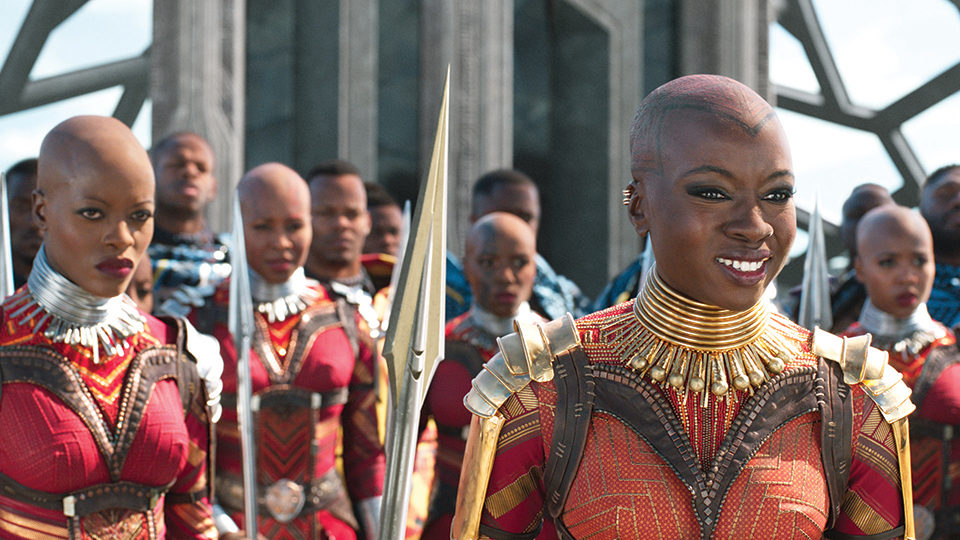
Black Panther
That the most exciting bits of Black Panther have to do with world-building—the futuristic costuming, the urban design, the smooth assimilation of the technological into the everyday—point to another problem with the CGI-driven mass destruction template of science fiction: it doesn’t account for the ways in which the cultural place of technology—and the resultant shape of our technophobia—has evolved over time. As digital and virtual networks infiltrate our everyday lives and subjective experiences, our relationship with technology manifests less as the fear of invasion by mysterious foreign forces, and more as an intimate grappling with newly mediated realities of time, space, and interpersonal relationships—i.e., less as the black monolith from 2001: A Space Odyssey, and more as the metaphorical “black mirror,” the small, hyperconnected screen prone to catching us in moments of accidental self-contemplation. Indeed, these concerns find their richest articulation on television with Charlie Brooker’s zeitgeist-capturing Black Mirror, an anthology series that replaces spectacle with realistic—and often terrifying—speculation about our technologized future.
On the big screen, these speculative themes are generally the domain of “lo-fi” sci-fi: micro-budget indies that explore the existential implications of the genre’s staple premises without the accompanying special effects. Many of these films belong to the postmodern lineage of Chris Marker’s La Jetée (1962) and Alain Resnais’ Je t’aime, je t’aime (1968), whose basic conceit—representing the fragmented experience of time travel using tricks of editing and narration—is especially suited to science fiction on a budget. Both these films use the idea of time travel to explore the metaphysical workings of memory and trauma, creating a cinematic vision of technology as experienced rather than observed. Shane Carruth’s time-paradox thriller Primer (2004)—something of a lo-fi landmark, with its $7,000 budget and homemade special effects—employs a similar approach, but adds a contemporary indie touch. A Borgesian story about two young men who accidentally invent a time machine in their garage, the film blends low-key naturalism with hard science fiction, underlining its keen, gently satiric awareness of the unassuming power of modern-day tech. Parallel-world thrillers like Another Earth (2011), Coherence (2013), and The One I Love (2014) borrow the same formal template: by deftly deploying off-screen space and point-of-view editing, they conjure multiple universes and doppelgängers within a realistic, quotidian world. In these films, the stripped-down, effects-free production allows for a conceptual inventiveness that challenges us to imagine alternate and parallel realities in familiar settings.
Another emergent trend of lo-fi sci-fi skews closer to the Black Mirror formula and underscores the dystopian tendencies that already inform our present: it challenges us to recognize, as Charlie Brooker put it in a column in The Guardian, how “nuts-deep into the future we already are.” By introducing slight embellishments in an otherwise mundane and entirely plausible world, films like Her (2013), Ex Machina (2014), and Marjorie Prime (2017) throw into sharp relief the changes wrought by existing technologies on fundamental human experiences like learning, loving, and dying. Michael Almereyda’s Marjorie Prime, for instance, is set in the near future where people cope with bereavement using “Primes,” or 3-D holographic versions, of the deceased; in a not-so-far-fetched extrapolation of current machine learning technology, the Primes learn to emulate their referents by absorbing memories through conversation. Other than a couple instances in the film in which solid objects are shown passing right through the holograms, Marjorie Prime lacks special effects of any sort. Instead, through a series of conversations between various characters and Primes, the film movingly brings to life a central conundrum of the digital era: moving on from the past whilst having the capacity to archive it in increasingly vivid forms.
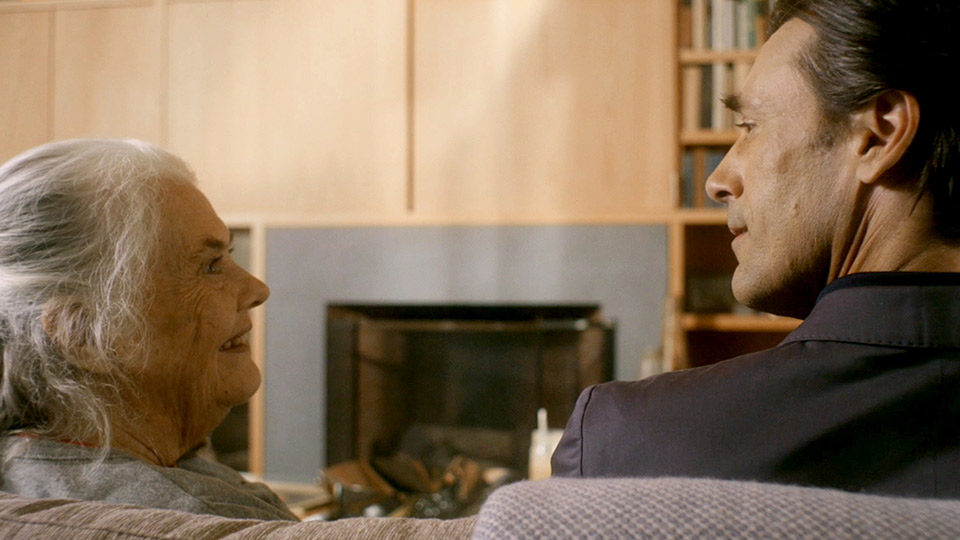
Marjorie Prime
An early, fairly obscure precursor of this brand of lo-fi sci-fi—in which the future is treated as having already arrived in the present—is Ritwik Ghatak’s Ajantrik (Pathetic Fallacy, 1958). Set in Bihar about a decade after Indian independence, the film chronicles the unusual companionship between eccentric taxi driver Bimal and the battered 1920 Chevrolet jalopy he affectionately calls Jagaddal (meaning “immovable” in Bengali). The science-fiction elements in Ajantrik are elusive by design: Jagaddal’s possible sentience is hinted at simply through anthropomorphic sound effects (sighing, drinking) and the occasional autonomous movements of its headlights; it’s unclear if the car is actually a conscious being, or if the film is just merrily playing along with Bimal’s delusions. (“I’m a machine. I like the smell of burnt gasoline. It makes me high…,” he says at one point.) This ambiguity frames the film’s futurism as a satire—perhaps, even a parody—of the fetishization of machines in newly industrializing India.
However, Ghatak operates in a double register in Ajantrik, imbuing the idea of an “already arrived” future with a deeper political significance. Interspersed with glimpses of northeastern India’s tribal peoples—who are seen in front of factories, in fields, and in festive celebration throughout the film—Ajantrik finds an affinity between the animism inherent to Indian folk traditions and the techno-fetishism encouraged by industrialization. An integrated, technological lifestyle is not a foreign imposition or even a futuristic notion, Ghatak seems to suggest, but an organic extension of India’s cultural history. In the same vein as Black Panther’s defiant blend of tradition and technological advancement, Ajantrik uses the temporal plasticity of science fiction to propose that what we designate as the “future” might be found in the histories and present-day realities of those who are excluded from mainstream narratives of progress (or decline).
The most potent lo-fi sci-fi seizes upon this idea, leveraging the genre’s premises to recenter the real cultural experiences of the marginalized. For instance, the two worlds in John Sayles’s The Brother from Another Planet (1984)—the home planet of the alien, where slavery still exists, and Harlem of the 1980s, where he crash-lands after escaping his owners—represent two different points in African-American history, and allow for a thoughtful (and comedic) reflection on both. In a gendered version of the alien-on-earth story, Jonathan Glazer’s Under the Skin (2013) deconstructs the everyday experience of femininity by—quite literally—repurposing actuality as supernatural fiction: much of the movie consists of Scarlett Johansson, who plays a succubus-like alien, driving through the streets of Glasgow and chatting up random men. The twist is that many of these scenes were shot guerrilla-style with unsuspecting non-actors, making the film a revealing documentary of men’s interactions with a (mildly) exotic woman. Although not exactly “lo-fi,” Alexander Payne’s recent release Downsizing also uses a futuristic gimmick to ultimately shed light on the real and everyday exploitation of minorities. In the movie, a technological solution to climate change shrinks people so they can live in tiny but lavish communities that consume far fewer resources than human-sized ones. When Matt Damon’s Paul Safranek undergoes the procedure and moves to “Leisureland,” he discovers, with the aid of a disabled Vietnamese dissident shrunk against her will, that the racial and class inequalities of the normal-sized world persist—and are perhaps even intensified—in this eco-friendly micro-utopia.
There are glimpses of these sobering realities in Black Panther as well: in an especially moving scene, Erik Killmonger relives the death of his father in their Oakland apartment using the radioactive elixir of the Heart-Shaped Herb, and when asked why he isn’t moved to tears, his young self shrugs and says “Everybody dies. It’s just how it is here.” At the end of the film, Killmonger makes another statement about living in imprisonment and bondage that gestures toward the turbulent life experiences that fuel his angst. That the film confronts these issues head-on, without the crutch of allegory, is rare in itself, but what makes Black Panther truly unique is that this “dystopian” present is juxtaposed with a (stunningly staged) utopian vision that is also wholly steeped in the black experience—in its history, iconography, and culture. In doing so, Black Panther gives blockbuster science fiction its new vocation: a grounded and inclusive reflection of reality that isn’t closed off by mass spectacle, but instead—in the tradition of Afrofuturism—allows for radical reimaginings of both the past and the future.
Closer Look: Black Panther is in theaters now.
Devika Girish is a freelance film critic based in New York.







